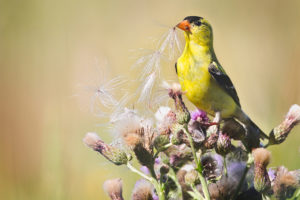
These bright black, yellow and white small-stature finches can be spotted in the spring and summer in weedy fields and floodplains. Unlike many species who nest and train their young in the early spring, goldfinches mate and nest in the summer so that they can collect the seeds of plants for their nests and to feed their young. Goldfinches can be seen at birdfeeders year-round, but may not be as easily identifiable as they are in the summer, because goldfinches are the only finch that molts its body feathers twice a year, once in late winter and again in late summer. The brightening yellow of male goldfinches each spring is one welcome mark of approaching warm months.
American Goldfinches are one of the strictest of vegetarian birds, only eating the occasional accidental insect. Goldfinches eat seeds including seeds from composite plants (in the family Asteraceae: sunflowers, thistle, asters, etc.), grasses, and trees such as alder, birch, western red cedar, and elm. At feeders they prefer nyjer and sunflower.
Male and female goldfinches move around together to choose a suitable nest site. The female builds the nest, usually in a shrub or sapling in a fairly open setting rather than in forest interior. The nest is often built high in a shrub, where two or three vertical branches join; usually shaded by clusters of leaves or needles from above, but often open and visible from below.
American Goldfinches are active, acrobatic finches that balance on the seedheads of thistles, dandelions, and other plants to pluck seeds. They have a bouncy flight during which they frequently make their po-ta-to-chip calls. Although males sing exuberantly during spring, pairs do not nest until mid-summer, when thistles and other weeds have gone to seed. Goldfinches do not join other songbirds mobbing predators.
Did you know? The American Goldfinch is the state bird of Washington?
OR, that goldfinches fall less for the Cowbird’s antics, as their seed-only diet cannot sustain the intruder Cowbird young?
Don’t forget to submit your photos to the 2018 Ridgefield National Wildlife Refuge Photo Contest by September 3rd!